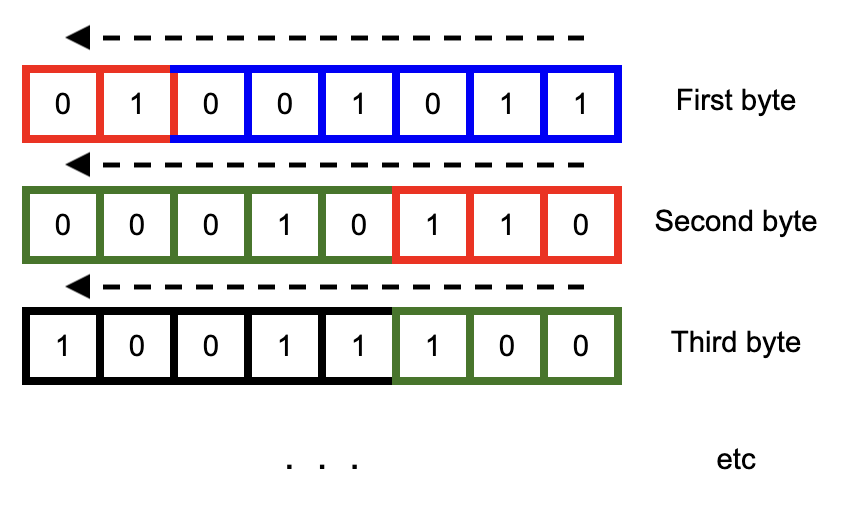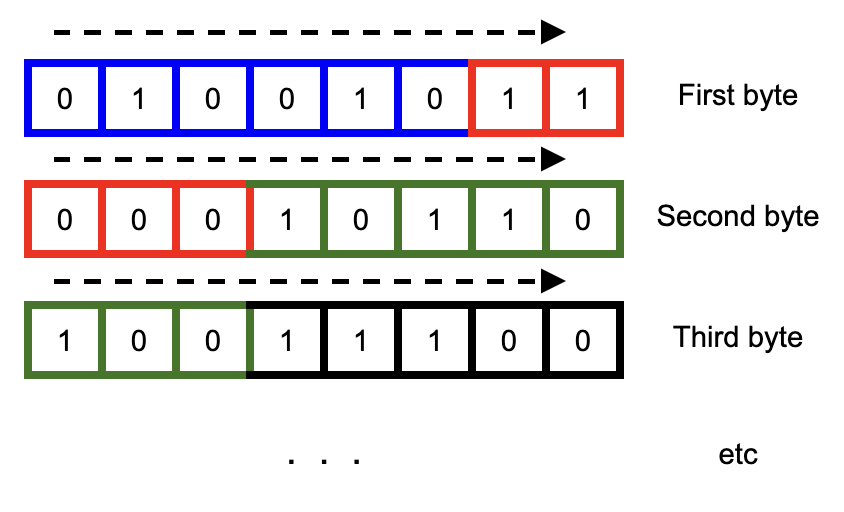bitjs
bitjs.io
This package includes stream objects for reading and writing binary data at the bit and byte level: BitStream, ByteStream.
Streams are given an ArrayBuffer of bytes and keeps track of where in the stream you are. As you
read through the stream, the pointer is advanced through the buffer. If you need to peek at a number
without advancing the pointer, use the peek methods.
BitStream
A bit stream is a way to read a variable number of bits from a series of bytes. This is useful for parsing certain protocols (for example pkzip or rar algorithm). Note that the order of reading bits can go from least-to-most significant bit, or the reverse.
Least-to-Most Direction

const bstream = new BitStream(ab, false /* mtl */);
bstream.readBits(6); // (blue) 0b001011 = 11
bstream.readBits(5); // (red) 0b11001 = 25
bstream.readBits(8); // (green) 0b10000010 = 130
Most-to-Least Direction

const bstream = new BitStream(ab, true /* mtl */);
bstream.readBits(6); // (blue) 0b010010 = 18
bstream.readBits(5); // (red) 0b11000 = 24
bstream.readBits(8); // (green) 0b10110100 = 180
ByteStream
A ByteStream is a convenient way to read numbers and ASCII strings from a set of bytes. For example,
interpreting 2 bytes in the stream as a number is done by calling someByteStream.readNumber(2). By
default, the byte stream is considered Little Endian, but can be changed at any point using
someByteStream.setBigEndian() and toggled back with someByteStream.setLittleEndian().
If you need to peek at bytes without advancing the pointer, use the peek methods.
By default, numbers are unsigned, but peekSignedNumber(n) and readSignedNumber(n) exist for
signed numbers.
const byteStream = new ByteStream(someArrayBuffer);
byteStream.setBigEndian();
byteStream.skip(2); // skip two bytes.
// Interpret next 2 bytes as the string length.
const strLen = byteStream.readNumber(2);
// Read in bytes as an ASCII string.
const someString = byteStream.readString(strLen);
// Interpret next byte as an int8 (0xFF would be -1).
const someVal = byteStream.readSignedNumber(1);
...
Appending to the Stream
If you get more bytes (for example, from an asynchronous process), you can add them to the end of
the byte stream by using someByteStream.push(nextBytesAsAnArrayBuffer).
Forking / Teeing the stream.
If you have a need to seek ahead to a different section of the stream of bytes, and want to later
return to where you left off, you should use tee() method to make a copy of the ByteStream. This
will let you seek to the appropriate spot to grab some bytes using the teed stream, while you can
pick up where you left off with the original stream.
const origStream = new ByteStream(someArrayBuffer);
const strLen = origStream.readNumber(4); // Bytes 0-3.
const strOffset = origStream.readNumber(4); // Bytes 4-7.
const teedStream = origStream.tee();
const description = teedStream.skip(strOffset).readString(strLen);
const someOtherVal = origStream.readNumber(4); // Bytes 8-11
Note that the teed stream is not “connected” to the original stream. If you push new bytes to the original stream, the teed stream does not see them. If you find this behavior unexpected, please file a bug.